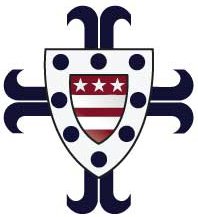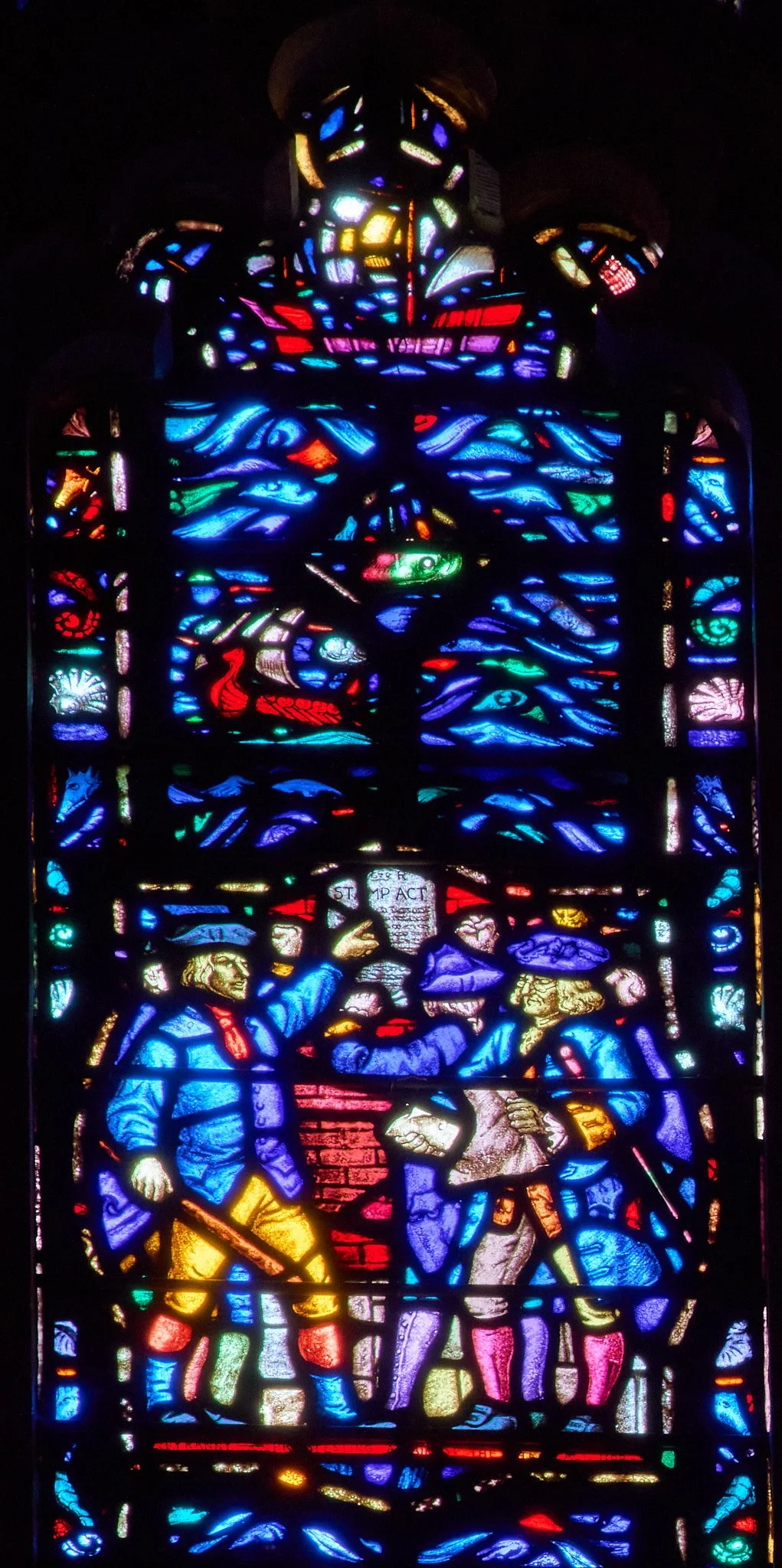
John Paul Jones
Window of the Revolution
“IN THE WORLD YE SHALL HAVE TRIBULATION: BUT BE OF GOOD CHEER; I HAVE OVERCOME THE WORLD. ”
—John 16:33B
Overview
This window highlights emblematic scenes of the Revolution, from its cause to conclusion—an eighteen year period.
It evokes Captain John Paul Jones’s exploits as “Father of the American Navy” through wavy shapes, edges decorated with seahorses, seashells, ships, an overall blue coloration (in this case a nod to the sea), and a medallion depicting Jones’s most famous sea battle.
This window also emphasizes the quintessentially American can-do spirit which Jones is most remembered for, a virtue which time and again helped Patriots snatch victory from the jaws of defeat. Of all the side windows in the Chapel, this one most directly relates to its honoree.
– NKH
Motifs Throughout
Since the John Paul Jones Window was given, in part, as a memorial of the “Father of the American Navy,” The Reverend W. Herbert Burk and D’Ascenzo developed a nautical theme. Thus, the “ground” of the window is in shades of blue and green-blue, evoking ocean waves; the bands on either side contain repeating motifs of seahorses and shells. This was the first window to be completed, and it is the only window which does not contain a geometric pattern as a ground.
Shells: Cowrie, Conch, Scallop
Seahorses: Blue-green and red-orange
– JRW
“To the Glory of God, in honor of John Paul Jones, Captain, U.S.N. and in memory of Richard Dale, November 6, 1756 – February 26,1826, First Lieutenant of the Bon Homme Richard, Captain, U.S.N. June 5, 1794, Commodore, 1801. This window is given by his great-grandson Edward C. Dale 1917”
Original Installation: April 15, 1917
Repaired and restored through gift of:
The Color Guard, Pennsylvania Society of Sons of the Revolution.
Rededication: October 30, 2016
Medallion Reading Order:
Top down on the left, then top down on the right
John Paul Jones Window of the Revolution
Although Jones’ flamboyant lifestyle is better-known than his Presbyterian upbringing, a 1790 letter encouraging his quarreling sisters to reconcile reveals another side of this rough sailor:
“[T]he sphere in which Providence has placed us as members of society requires the exercise of brotherly kindness….Every lesser virtue may pass away, but charity comes from Heaven and is immortal.” [1]
NKH
Medallions and Intermedallions
Each of the windows in Washington Memorial Chapel have “medallions” depicting scenes or stories. In between those major medallions are smaller “intermedallions” which represent a theme or motif.
The slider below shows each medallion with an overview of the scene. To read the detailed text of each medallion and intermedallion scroll below to the toggle boxes for the full text.
Detailed Medallion Text
-
Medallion 1: Tearing Down the Stamp Act
Location: Top of the left hand column
Description:
TEXT
Intermedallion [Preceding Stamp Act]
Early American Navy Ship: Naval vessel flying the Continental Union Flag used from 1775-77.
Fish: Center lozenge: A green and red fish. Coloring implies dolphinfish (mahi-mahi), a colorful and agile creature often spotted leaping near boats in the warm ocean waters of the Caribbean. The figure may have been included as a nod to decorative illustrations on older maps.
Viking Longship: Distinctly Norse—red hull, dragon-headed prow, and square sail. While certainly associated with Viking predatory acts, the Scandinavian Longship also represents Viking prowess as explorers and navigators. Over time, their culture was exposed to Christianity by the Frankish missionary Ansgar and many others. Leif Erikson, credited as the first European to set foot in the Americas, is portrayed in the Norse sagas as being blown off course on his way to missionize Greenland. Archaeological discoveries in 1960 indeed proved the legendary account of Christian Norsemen having landed in what is now Newfoundland, Canada c. 1000 AD.
NKH
-
Medallion 2: The Battle of Lexington
Location: Left hand colum, under number 1
Description:
TEXT
Intermedallion [The Battle of Lexington]
Shell Cross: Center lozenge: A cross consisting of four red turret shells flanked by blue scallop shells.
NKH
-
Medallion 3: Washington Taking Command at Cambridge
Location: Left column under number 2
Description:
Text
Intermedallion [Preceding Washington Takes Command]
Ship’s Prow (facing right): One of two highly stylized prows depicted in this window. Inclusion may be intended as an obscure naval pun from the well-read Burk, since “prow” can also mean “valiant, brave, gallant.” According to the Oxford English Dictionary this medieval usage was common in poetry from the 1800s into the early 1900s.
Hessian Soldier: Soldier wearing distinctive mitred brass cap of Hessian grenadiers. His uniform particularly resembles that of the Hessian auxiliaries under the command of Colonel von Rall (see Crossing the Delaware below). A small number of Hessians defected and fought for the Patriots during the war, in part because Congress enticed them with offers of land. Five thousand or more of the Hessian conscripts became Americans after the war (both defectors and prisoners).
NKH
-
Medallion 4: The Evacuation of Boston
Location: Left column, under number 3
Description:
xx
Intermedallion [Preceding Evacuation of Boston and Crossing the Delaware]
Portrait of John Paul Jones: Center lozenge: This is the only miniature portrait of its kind in the Chapel windows. It may have been included so that Jones’s actual likeness would be visible in the window bearing his name, as the scene depicting his valor at the Battle of the Bonhomme Richard and the Serapis is drawn to the scale of the ships.
NKH
-
Medallion 5: Washington Crossing the Delaware
Location: Left column, under number 4
Description:
x
Intermedallion [Washington Crossing the Delaware]
Florentine Coat of Arms: Center lozenge: Argent, an iris gules. This was initially borne by the Guelphs, factions supporting the Pope in the Investiture Controversy, a series of late-9th century disputes concerning the selections of bishops and abbots. The Ghibellines, who supported the Holy Roman Emperor’s authority, wore the same emblem with the colors reversed. After the Guelphs consolidated their control in the City of Florence, they further fragmented into the Black and White Guelphs, based respectively on whether they supported or opposed further Papal control of Florentine affairs. Dante, a member of the latter faction, was part of a deputation to Rome during the Sack of Florence in 1301 by the Black Guelphs, and was thereafter sent into exile, during which time he began to compose the Divine Comedy.
JFW
-
Medallion 6: The Surrender of Burgoyne
Location: Left column under number 5
Description: x
Intermedallion [Preceding The Surrender of Burgoyne]
Ship’s Prow (facing left): Second of two prows appearing in this window. As noted previously, may be a metaphoric use of the word “prow” to imply “valiant, brave, gallant.”
Patriot Soldier: Standing at attention; wearing Continental Army uniform (red facings).
NKH
-
Medallion 7:Building the Huts at Valley Forge
Location: Right column, top
Description: x
JRW
Intermedallion [Preceding Building the Huts at Valley Forge]
Galley: The galley was a type of ship initially developed in the Mediterranean basin. Typically lateen-rigged, galleys were powered by rowers, which provided a competitive advantage in close-quarters warfare during the Age of Sail. The Rhode Island General Assembly authorized the construction of two “row galleys” in 1775, the Washington and the Spitfire, to defend the Narragansett Bay. Following the declaration of American Independence, these were dispatched to join the fledgling American Navy at New York. On August 16, 1776, the Washington was the flagship of a successful attack on the British ships Phoenix and Rose; no further record of the Washington exists following the capture of New York that autumn. Row galleys also played an important role in the Battle of Valcour Bay, Lake Champlain in 1776.
Waves: Center lozenge: blue and green waves. The continuation of the window’s background waves into the center lozenge emphasizes the vast expanse of the open sea.
JRW
-
Medallion 8: Martha Washington Ministering to the Sick Soldier at Valley Forge
Location: Right column, under number 7
Description: x
Intermedallion [Preceding Martha Washington Ministering to the Sick Soldier at Valley Forge]
Ship: Center lozenge: a small, square-rigged sailing ship.
Patriot Soldier: Leaning on musket; wearing Continental Army uniform (buff facings).
JRW
-
Medallion 9: Celebrating the French Alliance at Valley Forge, May 6, 1778
Location: Right column, under number 8
Description: x
Intermedallion [Preceding Celebrating the French Alliance at Valley Forge, May 6, 1778]
Anchor: Center lozenge: A red anchor on a blue field. In the Epistle to the Hebrews, Christ, as the only hope of salvation, is likened to an anchor; consequently, the anchor is widely seen as an emblem of hope - hence the emblem on the seal of the State of Rhode Island.
JRW
-
Medallion 10: The Battle of the Bon Homme Richard with the Serapis
Location: Right column, under number 9
Description: x
Intermedallion [Preceding The Battle of the Bon Homme Richard with the Serapis]
Shell Cross: Center lozenge: A cross consisting of four red turret shells flanked by violet scallop shells.
Indian: Figure wearing blue blanket and red headdress, possibly meant to indicate Patriot allegiance. The majority of Native American nations in the area of conflict remained neutral or directly sided with the Crown, due to both monetary incentives and territorial considerations. However, a few tribes—notably the Oneida, Tuscarora, Catawba, Maliseet, and Stockbridge-Mohicans (some of whom served as Minutemen)—allied themselves with the American colonists.
JRW
-
Medallion 11: The Surrender of Lord Cornwallis at Yorktown
Location: Right column, under number 10
Description: x
JRW
-
Medallion 11: The Return of the Soldier and the Hanging of the Musket
Location: Right column, under number 11
Description: x
Intermedallion [The Return of the Soldier and the Hanging of the Musket]
Lantern: Center lozenge: Ship’s lanterns were usually made of tin and originally enclosed with sheets of scraped cow’s horn, hence the old name “lanthorn.” Horn was susceptible to heat and hungry rodents, so in time this was replaced with sheets of mica; by the late 18th century, newer and tougher forms of glass began to be used, but mica remained common throughout the Revolutionary era. Although this particular lantern shines a red light, the convention of red for port and green for starboard was not adopted until the middle of the 19th century.
JRW
© Text copyright of Washington Memorial Chapel and courtesy of the God's Glass Project.
© Photos copyright of Sam Cornwall, licensed exclusively to Washington Memorial Chapel and courtesy of the God's Glass Project.
Unauthorized sharing or distribution of text or images from this website is strictly prohibited without written permission from the copyright holders.












